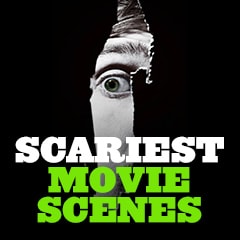
|
| Movie Title/Year and Brief Scene Description | |||||||||||||||||
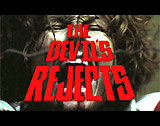
|
The Devil's Rejects (2005) #7 This brutal, repellent, uncompromising and sick grindhouse film by writer/director Rob Zombie, a rampaging road film, was the sequel to his debut feature House of 1000 Corpses (2003). The abhorrent exploitation film told about a lunatic tribe of hillbilly serial killers (the Fireflys, with names borrowed from characters played by Groucho Marx) on the backroads. As the villains of the Dr. Satan murders from the previous film, they were fleeing from the law across the state, from vengeful Texas Sheriff Wydell (William Forsythe) whose brother George was murdered by the family. It was filled with degraded, brutal scenes of murder and dismemberment, and mostly awful, distasteful and unpleasant sequences. In an early scene, stringy, blonde-haired
fugitive leader Otis P. Driftwood (Bill Moseley) cuddled with a decomposing
female corpse (Jessica Helmer). Otis and his
crazy sister Baby (Sheri Moon Zombie, the director's wife) (later joined
by their demented father with evil clown makeup, Captain Spaulding
(Sid Haig)) terrorized, tortured and tormented five members of a close-knit
traveling country music band called "Banjo &
Sullivan," found in their Khaki Palms motel room. Baby
seductively enticed bandleader Roy Sullivan (Geoffrey Lewis) in order
to gain access to the room.
The sole surviving Wendy was forced to wear an organic mask made from husband Adam's skinned face. Wendy hysterically ran for help into the middle of the road and tried to wave down a car. A big semi-truck flattened her, and her body was left a bloody mess on the pavement. Sheriff Ken Dwyer (Steve Railsback) commented on the scene of explosive carnage:
In the final bloody scene (to the tune of Lynyrd Skynyrd's "Free Bird"), badly-wounded Otis (driving), Baby and Spaulding (in the back seat) suicidally drove a 1972 Cadillac Eldorado convertible into a phalanx of police officers armed behind a barricade. |
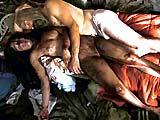 Otis with Decomposing Corpse 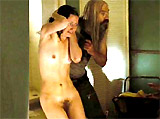 Wendy Dragged Naked 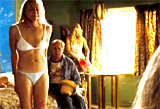  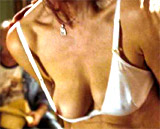 Sexual Humiliation of Gloria 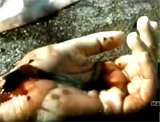 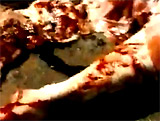 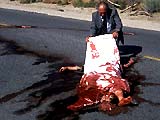 Masked Wendy's Death 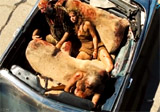 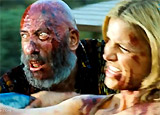 Final Massacre |
|||||||||||||||
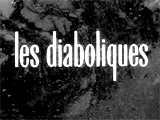
|
Les Diaboliques (1955, Fr.) #49 Despicable and abusive schoolmaster Michel Delassalle (Paul Meurisse) badly mistreated his downtrodden, humiliated, frail and ailing wife/headmistress Christine (Véra Clouzot, director Georges Clouzot's real-life wife) and brassy schoolteacher-mistress Nicole Horner (Simone Signoret). In the film's famous shocking twist ending after following a curving plotline, Michel was never killed by the two women. He had faked his own death - with collaborative help by Nicole - so he could murder long-suffering, invalid 'widow' Christine. When she unexpectedly saw tyrant Michel's corpse in the bathtub, it caused her (and the audience) to have a fright-induced heart attack, when he rose zombie-like out of a bathtub with half-opened, all-white eyes. She thought he was dead from drowning.
She clutched her chest in the vicinity of her heart, fell back against the wall and slid to the floor where she collapsed. After rising, he removed fake white covers from each eyeball. |
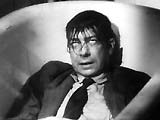 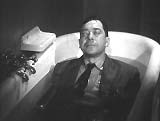 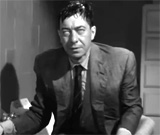 Michel's Zombie-Like Emergence From Bathtub  Removing Fake Eye Lenses |
|||||||||||||||
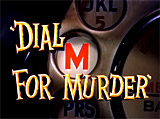
|
Hitchcock's 3-D thriller masterpiece told about a charming, sophisticated yet villainous husband - an ex-tennis pro, who masterminded the murder of his unfaithful wealthy wife for having an affair with TV mystery writer Mark Halliday (Robert Cummings), so that he could inherit her fortune. Tony Wendice (Ray Milland) blackmailed or "influenced" Captain Lesgate/Swann (Anthony Dawson), a former classmate with a criminal record, to commit the "perfect murder" for £1,000 pounds cash - the murder of Margot Wendice (Grace Kelly). During the attempted strangulation scene, the tension was ratcheted up. Tony's plan was to have his wife leave her bedroom to answer the living room phone, to enable Swann to strangle her from behind the window curtains where he was hiding. Tony dialed the number (dialing M for murder), but because his watch had unexpectedly stopped, he was about eight minutes too late. The assassin was frazzled and about to leave because of the delay. When the phone finally rang, the camera slowly panned to the left around Margot as she answered. The camera moved to view Swann's position behind the curtains. Reflections from the fireplace played upon the walls in the darkened room. He approached with a twisted scarf and wrapped it around her neck. But she foiled his strong attack by fighting back.
There was the tremendous 3-D effect of Margot reaching back behind her - into the audience from the screen - searching for a weapon (a pair of scissors) to defend herself and kill the assassin by stabbing him in the back. When he theatrically fell to the floor onto his back, the blades of the scissors were pushed more deeply into his body. |
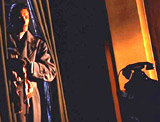 Captain Swann/Lesgate Awaiting Call 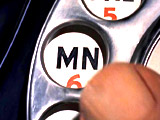 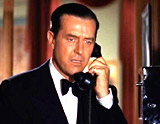 Magnified Phone During Phone Dialing |
|||||||||||||||
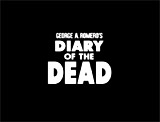
|
#8 The fifth, low-budget film in George A. Romero's Dead series was considered a modern-day, rebooted or updated, 21st century reimagining of the first Romero film. It postulated that political/social unrest - and the zombie infestation - was now a worldwide phenomenon. Romero designed it for the passive, detached YouTube and myspace.com media-saturated generations. One line captured the film's point of view about the ubiquitous nature of video cameras, people's compulsion to use them, the obsession to watch, and the necessity to record events in order to make them real -- "If it didn't happen on camera, it's like it didn't happen, right?" The entire movie was a "film-within-a-film" titled The Death of Death - a documentary of the unexplainable zombie phenomenon (mostly with long takes and jerky hand-held digital video camera shots). It was shot by film students after they discovered a real zombie uprising. Composed of first-person video footage (from security surveillance cameras, news footage, digital camcorders, YouTube, cell-phone cameras, etc.), it was edited together by Debra Moynahan (Michelle Morgan), the girlfriend of a posthumously-dead film-making boyfriend Jason Creed (Josh Close) - and then uploaded to the Web with 'scary music' added. The students believed the government was lying about the causes of the zombie resurrection, and vowed to show the world the truth of what had really happened. It began with conflicting and dubious news reports that told that there were no clear reason for the chaos in the world, although there was speculation about some kind of germ or epidemic, or natural calamity, or even that everything was a massive hoax. Student film-makers were interrupted while making a Blair Witch Project-like horror film, and they determinedly took their video cameras and other gadget-techno devices on the road to tell the real truth of the zombie attacks with their own first-person footage. The film opened at a crime scene in the town of Homestead, where an unidentified husband shot his wife and 16 year-old son and then blew his own brains out. The dead family was a suspected immigrant couple with no ID papers. In the news footage, as the corpses were wheeled out of the apartment building and into the back of an ambulance, suddenly, the body of the female woke up and began to move on the gurney, and she bit the neck of an medical services member providing aid. And then the son became reanimated as well and attacked another EMS crew member. Officers opened fire on the two zombies, and news-reporter Bree was bitten in the face before both could be stopped, by shooting them in the head. And then it became clear what was happening - Debra described the student film-making project and its relation to the late-breaking news over a three day period, and the young filmmakers' desire to tell the real truth of the zombie attacks with their own first-person footage. Jason, always behind the camera and filming, recorded their journey with student Mary Dexter (Tatiana Maslany) driving a run-down Winnebago to Debra's home in Scranton, Pennsylvania. The official television news version of the zombie attacks was that they were only isolated, unrelated incidents and terrorism was not involved. It was speculated that a virus strain may have caused a "mass psychosis." Jason forced each individual in the RV to introduce themselves to the camera as part of the historical, documented record of events. During their trip, they came upon zombies in the road after a horrific crash, and in the seemingly-abandoned Parkdale Hospital, they found a zombie surgeon eating the flesh of a hospital patient - he could only be stopped by Gordo (Chris Violetti) shooting him in the head. A zombified nurse also threatened them - Debra shocked both sides of her head with a defibrillator (causing her eyes to explode). Shortly later, Eliot (Joe Dinicol) grabbed an IV pole and stabbed a zombie four times in the body to show how the patient was really "dead" - but still alive as a zombie, and then finished the ghoul off with a jab to the forehead. |
 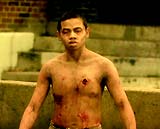 Opening Crime Scene   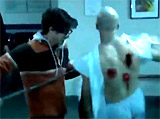 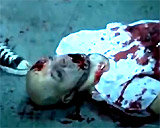 Hospital Scene |
|||||||||||||||
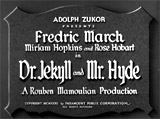
|
Dr. Jekyll and Mr. Hyde (1931) This classic horror story was the first sound version of the story, adapted from Scottish author Robert Louis Stevenson's 1886 Gothic literary novella "Strange Case of Dr Jekyll and Mr Hyde." It was a story of transformative identity into bestiality and sexual deviancy. It told about a kind but fatally-curious medical doctor named Dr. Henry Jekyll (Fredric March) (pronounced "Jee-kall") who adventured into the unknown by self-testing an experimental serum formula that released the uninhibited, subconscious evil in his soul, and caused him to develop a monstrous split personality, as Mr. Hyde. There were many scary scenes - most of them Dr. Jekyll's transformations after drinking a potion in his laboratory. During the film's first transformation scene (filmed in one-take) of Dr. Jekyll, he almost instantly grabbed at his throat as he was changed into the frightening Mr. Hyde - a bullying, jagged-toothed, beastly, hairy, sexually libidinous, Neanderthal-like, bedeviled creature. The laboratory room began to dizzingly spin around him. Jekyll (as Edward Hyde) grotesquely exclaimed in front of a mirror: "Free - free at last"; he boasted to his adversaries: "Mad, Lanyon? Carew? You hypocrites, deniers of life. If you could see me now, what would you think?" and then gave a maniacal laugh.
Soon after, Dr. Jekyll decided to revert back to Mr. Hyde during a second stunning and torturous transformational sequence that included painful grimaces and grunts. The amoral, brutish, cackling and mean Mr. Hyde headed out in the darkness to locate a Cockney slut "Champagne Ivy" Pearson (Miriam Hopkins), who worked as a barmaid at the Variety Music Hall, whom he had met earlier in his persona of Dr. Jekyll. He taunted and brutally mishandled Ivy, and forced his affections on her, and compelled her to go with him back to her place with the promise of wealth: ("I hurt you because I love you. I want you, and what I want, I get! I grant you, I am no beauty, but under this exterior, you'll find a very flower of man"). With an extreme tracking close-up, the camera focused on Hyde's face as he came closer to Ivy's face, while enticingly ordering her to return with him: ("You'll come with me") - before the image went out of focus and turned black. Later in the story, Hyde again appeared at Ivy's place (after numerous other off-screen visits of brutality and rape). Hyde called Ivy his "little bird," and then also called her a "trull" (prostitute) - to express his self hatred and jealousy: ("You hate me, don't you? I'm not good enough for you!") over her affectionate preference for gentlemen such as Dr. Jekyll. She refused to be ordered to tell Hyde that she hated him: ("Tell me that you hate me!"), and cowered as she was forced to scream out to Mr. Hyde that she loved him: ("How you must love me. I want to hear you say it. Say it. Come, my wench. Say it!").
He threatened her as she shrunk in fear from him, that he would be gone for a few days and might reappear at any time to check up on her: "You don't know when I'll be back.... Remember, you belong to me, do you hear? You belong to me! If you do one thing that I don't approve of while I'm gone, the least little thing, mind you, I'll show you what horror means." To her horror, he explained how he would still be spending the evening with her: ("The last evening is always the sweetest, you know. And what a farewell this one will be. What a farewell! I don't know whether I shall be able to tear myself away from you"). He also forced her to sing her "Champagne Ivy" song and to submit to a kiss before the scene faded to black.
Eventually, Hyde murdered his lover-turned-tragic victim Ivy. He jealously told her that he knew all about her relationship with Dr. Jekyll: ("I know everything you do and everything you think!") - and accused her of only desiring Jekyll's love: ("You wanted him to love you, didn't you? I'll give you a lover now. His name is death!"). He then revealed that he and Jekyll were one and the same ("I AM JEKYLL") - before he strangled her in her bedroom. As she dropped to the floor, behind her was a sculpture of Cupid and Psyche. |
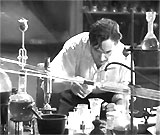 Dr. Jekyll Mixing Chemicals in His Laboratory 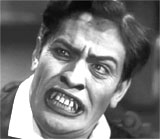 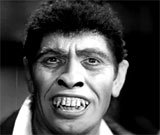 Jekyll's Second Transformation Into Mr. Hyde 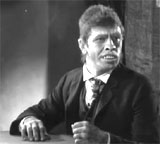 Mr. Hyde at the Variety Music Hall Where Ivy Worked, Demanding A Drink 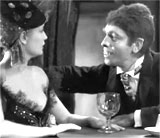 Jekyll With the Barmaid "Champagne Ivy" at the Music Hall 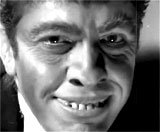 Hyde to Ivy: "You'll come with me" 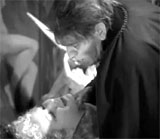 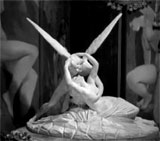 Hyde's Strangulation of Ivy: "I AM JEKYLL" |
|||||||||||||||
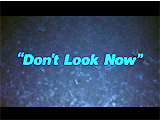
|
#22 Nicolas Roeg's supernatural, occult-themed thriller opened with the scary drowning death of a red raincoat-wearing young blonde daughter Christine (Sharon Williams) in an early scene set in England. Her father John Baxter (Donald Sutherland), an architectural restoration expert, sensed her impending death and raced out of the country estate to the pond. The anguished, grief-stricken father dragged her lifeless body to the muddy bank and delivered CPR, but he was too late and couldn't save her. He spent most of the rest of the film haunted by her death, with his similarly-distraught wife Laura (Julie Christie). Following the accidental death of their child, John and Laura traveled to Venice, Italy where he had been commissioned to restore an ancient church. During their time there, Laura met two elderly sisters: blind psychic Heather (Hilary Mason) and Wendy (Clelia Matania), and was shocked when Heather claimed she could 'see' her deceased daughter. Later, Laura attended a seance to try and contact her dead child - and was warned of danger in Venice. She informed John that it was not safe for them to remain, and she was forced to return to England to attend to their injured son. John continued to experience various glimpses and mysterious sightings of an elusive small figure in a bright red hooded coat in the dark Venice alleyways. In what turned out to be a deadly decision, he believed the figure was his daughter, and pursued what turned out to be his nemesis. He ascended a swirling staircase, assuredly telling the crying figure with its back to him: "I'm coming. It's okay. It's okay. I'm a friend. I won't hurt you. Come on." It wasn't his daughter - but a murderous serial-killer-dwarf (Adelina Poerio), who turned around, moved her head back and forth (a negative sign), withdrew a long sharp knife from her right coat pocket, and deftly sliced his neck and throat with one quick swing. He fell onto the stone floor and bled to death - punctuated by the peals of bells and a quick rush of evocative images from earlier in the film.
|
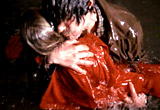 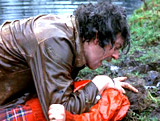 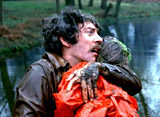 The Drowning Death of Red-Coated Daughter Christine |
|||||||||||||||
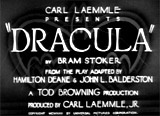
|
#79 This classic American horror film (the first sound horror film) from Carl Laemmle's Universal Pictures was an acclaimed masterpiece, directed by Tod Browning. The first glimpse of Transylvanian Count Dracula (Bela Lugosi), a 500 year old vampire, was shocking. He was standing upright next to his coffin, wrapped tightly in an all-enveloping black cape. His ashen face, with a piercing, unmoving, cold fixed gaze, was illuminated with an unholy glow from the twilight and his black hair was slickly combed straight back. Rats scurried about and wolves howled. Dracula was then seen sitting atop a carriage dispatched from the castle. He was a tall, silent figure, wrapped in a black cape and staring hypnotically straight ahead. Dracula made an elegant, black tuxedo-garbed entrance on a long and massive staircase, while holding a single candle, in the massive entryway of the castle. Rats and armadillos scurried across the dirt-covered stone floor. A giant spider web hung from the ceiling above the staircase. Dracula walked through the large spider web without disturbing it. Dracula glided forward and memorably introduced himself in an immaculately delivered line (uttered with a Hungarian accent):
He raised his eyes, and uttered with a lilting Hungarian accent after hearing the sound of wolves:
Later, crazed lunatic Renfield (Dwight Frye) was discovered on the ship Vesta that bore the casket of Dracula to England.
Renfield emerged in the hatchway from the hold of the death ship, stared up giggling and totally insane - obviously infected with Dracula's madness for the remainder of the film. |
 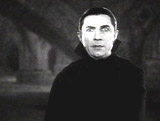 First Glimpse of Count Dracula 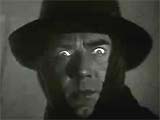 Dracula Atop Carriage  Giant Spider-Web Above Stairway in Castle Dracula  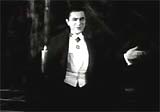 "I...am...Dracula" |
|||||||||||||||
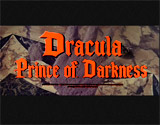
|
Dracula: Prince of Darkness (1966, UK) Director Terence Fisher's horror film sequel was another of the UK's effective Hammer Studios productions. It was the third entry in Hammer's Dracula series. In the first film (Fisher's Horror of Dracula (1958, UK)) also starring Christopher Lee, Dracula had been destroyed. In the second film of the series, the character of Count Dracula did not appear in the film, and was only mentioned twice.
A group of vacationing English tourists (two couples), including Alan Kent (Charles Tingwell) and his red-haired wife Helen (Barbara Shelley), found themselves at Dracula's deserted castle at Karlsbad in the Carpathian Mountains. They were surprised to be waited upon by Count Dracula's (Christopher Lee) creepy and strange manservant, Klove (Philip Latham), who startled them from the shadows. Klove had already placed their luggage cases in bedrooms, and the table was set for four people. He explained:
He then told them about his deceased master:
Alan didn't believe any of the superstitions or warnings: "You'll forget about all of this in the morning, you'll see," but his wife Helen was truly frightened and ominously predicted evil: "There'll be no morning for us." In the middle of the night (during a thunderstorm), an awakened Alan followed after Klove (hauling a heavy trunk or chest down the corridor). Alan discovered a secret passageway leading down to a crypt (with lit candles) containing Dracula's sarcophagus. From behind, Klove approached and stabbed Alan. During the ritualistic sacrificial-resurrection scene, Alan's fresh corpse was suspended by his legs (hooked up to a winch) over Dracula's opened tomb-sarcophagus during a Satanic ritual. After Dracula's urn of cremated ashes were sprinkled into the open sarcophagus, Klove slit the man's throat to let his gushing red blood mix with the ashes to awaken the legendary creature from the dead. Over a period of about a minute under smoke, Dracula's shape appeared, and his hand reached out over the edge of the sarcophagus, as lightning struck and thunder clapped.
Then, Klove also convinced Helen to proceed into the cellar ("Madam, your husband, will you come quickly?"), where she was so shocked by the sight of her husband's body drained of his blood that she could barely let out a terrifying scream. Bloodsucking Dracula appeared above her with a smile revealing fanged teeth - he made her his first undead bride with a bite to her neck, the sight of which was obscured by his black cape. |
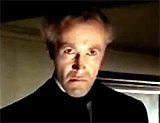 Dracula's
Manservant Klove (Philip Latham) Dracula's
Manservant Klove (Philip Latham) 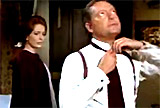 Guests at Dracula's Castle 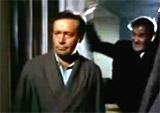 Klove Stabbing Alan 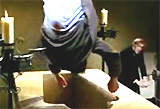 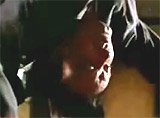 Alan's Corpse Suspended by His Legs Over Dracula's Tomb 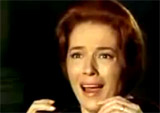 Helen Shocked by Sight of Dead Husband 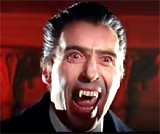
Dracula With Fanged Teeth |
|||||||||||||||
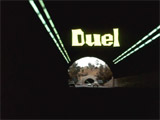
|
Duel (1971) #67 Director Steven Spielberg's feature-length film debut was this low-budget picture shot in less than two weeks (it was an ABC-TV "Movie of the Week" offering originally) - adapted from Richard Matheson's short story published in Playboy Magazine. Mild-mannered, distressed traveling salesman David Mann (Dennis Weaver), an LA electronics vendor, was driving in his red 1970 Plymouth Valiant, when he was relentlessly pursued on a rural California highway road by a demonic, killer diesel-engine truck (a 1955 Peterbilt 281 towing a tanker trailer). The greasy, grungy truck (with a FLAMMABLE warning) was driven by a hidden, faceless psychopathic driver (wearing cowboy boots) (stuntman and character actor Carey Loftin), although the truck itself personified a person (front window eyes, headlight pupils, front grill nose, front fender mouth, etc.). The driver exhibited stalking and many kinds of 'road rage' behaviors:
During Mann's last-stand confrontation with the monstrous homicidal truck, he gunned his overheated engine and proceeded to ram the truck - diving out at the last second. The explosive crash sent the truck (in slow-motion) over a cliff into rocks below. Mann stared at the burnt wreckage, as the credits rolled. |
 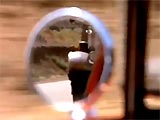 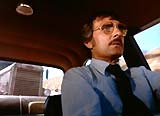 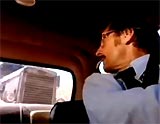 David Mann Pursued by Diesel-Engine Truck |
|||||||||||||||

|
Dumbo (1941) During the 'Pink Elephants on Parade' sequence of the film, both floppy-eared young Dumbo and companion Timothy Q. Mouse became intoxicated when they accidentally drank water from a bucket that had been spiked with champagne. Their psychedelic, nightmarish hallucinations - scary to them - included the sight of brightly-colored pink elephants singing, dancing, and playing trumpets. Another of the animated film's more terrifying scenes was the capture and confinement of Dumbo's mother Mrs. Jumbo when she was thought to be a rogue wild elephant. She had 'attacked' a bratty kid, in motherly defense, who was tormenting little Dumbo by pulling his large ears. |
 "Pink Elephants on Parade" 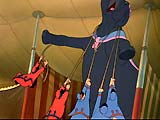 Mrs. Jumbo Enraged When Dumbo Teased |
|||||||||||||||
Intro | #s-A | B | C-1 | C-2 | D-1 | D-2 | E | F | G | H I-J | K-L | M | N-O | P | Q-R | S-1 | S-2 | S-3 | T | U-Z |